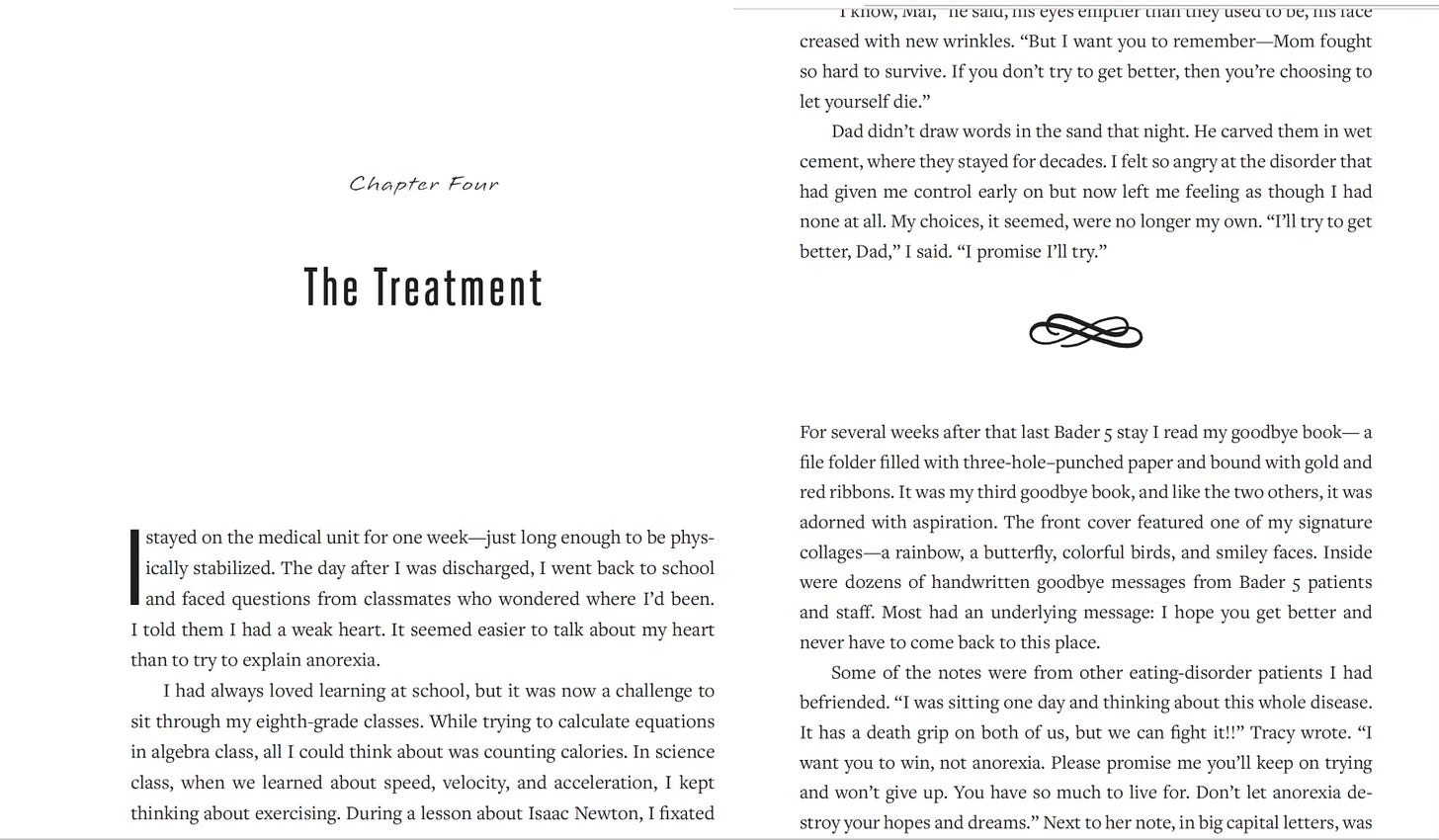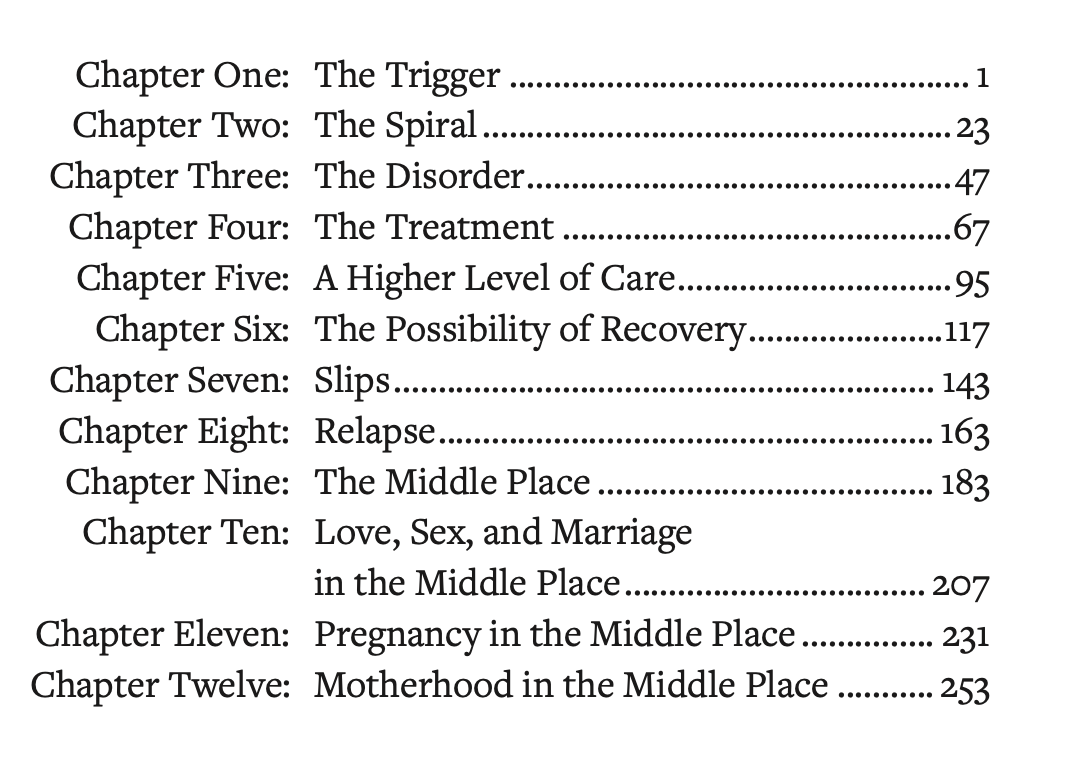How to structure a memoir that's equal parts narrative & reportage
Lessons learned from writing my debut book SLIP.
I can hardly believe that my book, SLIP: Life in the Middle of Eating Disorder Recovery, will be out in just a few days!
I hope that SLIP will change the narrative around how we talk about eating disorders and recovery from them. I also hope it will open up writers’ minds to new ways of thinking about how to approach memoir.
Some memoirs include a hint of reporting, and some nonfiction books include a hint of memoir. But what happens when you conceive of a nonfiction book that’s equal parts personal narrative and reportage?
I grappled with this question a lot while writing SLIP — a book that explores a long span of time in my personal life alongside loads of research and extensive reporting (175 interviews and a survey with 724 responses).
True to form, I had to write my way toward an answer. At first I started out with an alternating chapter approach in which I wrote one personal chapter followed by a reported one. I wrote the book’s first three chapters this way and shared them with my editor, hoping she would like what I’d done. She ultimately thought the content was strong, but she encouraged me to rethink the book’s structure by identifying the key topics that I wanted to cover, and then unpacking them chapter by chapter through these three lenses:
1. My childhood memories and journals
2. My adult reflections on my experiences
3. The research, science, and other perspectives that fill in my personal experiences
My editor said that reorganizing each chapter with this structure would build stronger narrative momentum and give the reader a clearer sense of how the book “works.” I liked this idea and reworked my chapter outline by splitting each chapter into two halves: a personal half and a reported half. I came up with a theme for each chapter, based on topics that were integral to both my life story and the reporting I had done.
I didn’t know of any other books that were structured this way, and neither did my editor. A lot of my inspiration stems from reading others’ work, so I was daunted by the prospect of not having any other books to turn to for structural guidance. But I also saw it as an opportunity — to experiment and carve out a new pathway forward for other writers who may be pursuing similar work.
******
I now refer to this structure as a “split-chapter approach.” In my book, the first half of each chapter is deeply personal and written from the perspective of my younger self. The second half is deeply reported and written from the perspective of my present-day self. Both halves are united by a central theme and separated by a design element (an infinity symbol).
The first half of my chapter on eating disorder treatment, for instance, dives deep into my stays at Boston Children's Hospital in the late 1990s. To write this, I consulted medical records, revisited the hospital, and interviewed my family members, friends, former medical doctors, etc. The second half looks at the evolution of eating disorder care since then and brings in related research, as well as insights from clinicians and perspectives from patients who were more recently hospitalized. This all stems from multiple interviews that I conducted during the reporting process.

I explained this structural approach in my Author’s Note so that readers would have some context going into the book. And I kept my chapters chronological to make them easier to follow; I didn’t want to require readers to do too much heavy lifting, especially since the subject matter isn’t exactly light. Chronological order was also important to me as a writer who wanted readers to first see who I was and what I was like pre-anorexia before seeing the girl I became once I got sick.
In many ways, the split-chapter approach gave me freedom — to dive deep into the personal, and to then delve into all the reporting I had done. I liked finding a structure that enabled me to make each chapter informative without sacrificing the intimacy and warmth of a memoir.
This structural approach also allowed space for my younger self and present-day self to be in conversation with each other. In the personal half of each chapter, I could rely on source materials and revisitations to re-inhabit my younger self and more authentically write from young Mallary’s perspective.
In the reported half, I could reflect on all of this as a mother in recovery and as someone who is no longer in the throes of my disorder. I didn’t include myself very much in the reported parts, save for a few lines here and there to remind the reader that I was still the book’s main character and narrator. In the reported parts, it was important to me to bring in other, more diverse voices.
Lastly, this structural approach helped me to illuminate the contrast between the “fully recovered narrative” I used to embody when I was younger and the “middle place” narrative I now live out as a woman who inhabits the grey space between acute sickness and full recovery. That fully recovered narrative used to feel inauthentic because I outwardly told everyone I was “over” my disorder even though I was still inwardly struggling.
Many times as I wrote my book, I was reminded of Kate Chopin’s The Awakening, in which she writes of the main character Edna Pontellier: “At a very early period she had apprehended instinctively the dual life — that outward existence which conforms, the inward life which questions.” As a memoirist, I wanted to convey this dual life on the page and show how, by the book’s end, my outward and inward lives were no longer in conflict. The split-chapter approach helped me do this.
******
Given that I was experimenting with something new structurally, I decided early on to use grant funds to hire a freelance editor who could give me frequent feedback. (Understandably, editors from publishing houses don’t always have the bandwidth to give monthly edits, but I felt like I needed this as a first-time author.)
The freelance editor, who is a longtime mentor of mine, read my chapters each month and sent me edits every few weeks. My publishing house’s editorial team also provided very helpful feedback at the beginning, middle, and end of the process. I was lucky to have so much support along the way, and I’m grateful that my editors encouraged experimentation.
My early readers said they thought the split-chapter experiment/approach worked well (a huge relief!), and they gave me great tips on how to improve the transitions from the personal part to the reported part. One of my early readers said she thought I was pioneering a new “explanatory memoir” genre. “The personal narrative and research/reporting anchor each other,” she said, “creating a 360-degree view through time and from personal to cultural/social.” This remains one of my favorite pieces of editorial feedback to date.
I hope other readers will find the structure compelling and informative, and I hope it will provide writers of all kinds with a newfound sense of what’s possible.
******
If you want to see this structure in action, I hope you’ll pre-order SLIP wherever you buy books. Starting next Tuesday (once the book is out), you’ll get to hold it in your hands! I also hope you’ll join me on my book tour.
I’m happy to answer your questions about my approach and process, so please feel free to share your questions/thoughts in the comments section.



Will there be an Audio book version? I would love to read this but I digest nonfiction much better that way.
Thank you for sharing this, very interesting!